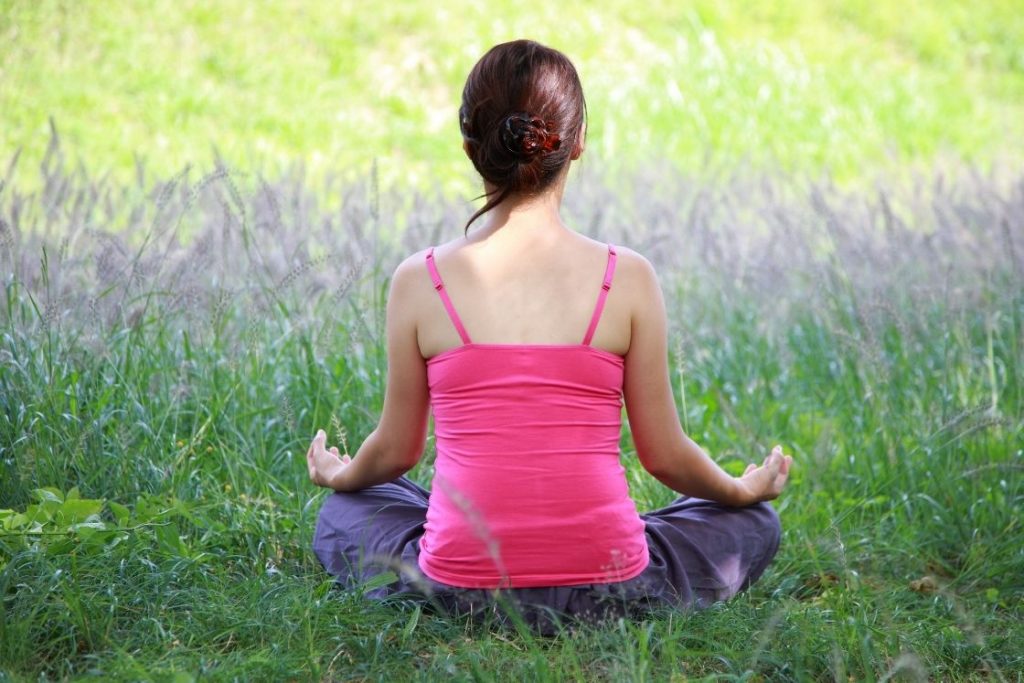
The root chakra is the 1st chakra present at the base of the spine symbolized by the red color. When your root chakra is blocked you feel insecure and disconnected.
Meditation is one of the most powerful ways to bring balance to the chakras. It helps with activating and balancing the chakra while keeping a healthy flow of energy throughout our body.
There are different meditation techniques for chakra healing that focus on each chakra, including visualization, focusing, chanting, etc. In this article, root chakra meditation is explained.
Root chakra characteristics
The root chakra location is the place of the kundalini energy in our body. It plays the role of the supporting chakra for all the other chakras that are located along the spine.
When the root chakra is imbalanced or blocked, you feel a surge in negative emotions like anger, fear, anxiety, insecurity, etc. You will not be able to trust other people easily, feel lazy, stagnant, and tired. You may also suffer from indigestion, eating disorders, and other physical ailments of the lower body.
Whereas when your root chakra is balanced, you will feel grounded and safe in your surroundings. Along with enhanced strength and vitality, you will be more focused and all negative thought patterns will fade away. A feeling of acceptance and belonging will also arise which will make you connected to your environment and surroundings.
To attain the above benefits of a healed root chakra, meditation, among other ways, is considered an effective tool. Root chakra’s grounding meditation will be of great help in re-energizing and getting you relaxed.
Also Read: Root Chakra Symbol and Its Signs of Balanced & Imbalanced
Root chakra meditation and its benefits
When you focus on practicing root chakra meditation, you are essentially targeting the chakra elements such as stability, security, and your basic survival instincts. It requires you to let go of your inhibitions and connect with yourself through self-accepting.
Even though your main focus is on activating and healing the root chakra, your entire body is taking part in the process and is a witness to the effects of meditation. Here are some benefits of root chakra meditation:
- Your thoughts will become positive, making you see the silver lining in any negative situation. You will have a positive attitude towards life.
- You will feel less stressed which will help you in enjoying your life.
- With a balanced root chakra, you will learn to accept yourself, giving way to better relationships with people and your environment.
- Meditation is a great form of healing. It will help you release feelings of anxiety, anger, fear, betrayal, and even aid in resolving heartbreak.
- When you are healed, you also tend to become compassionate and empathetic towards others, which is also beneficial for better relationships.
- One of the most identifiable benefits of meditation is that you can get a good sleep. This is due to a relaxed state of mind and clarity of thoughts.
- A balanced root chakra will enhance your awareness. You will be able to immediately identify an imbalance in your energy as you are connected with yourself and your chakra energy.
Tips to perform a root chakra meditation correctly
While you may think meditation is as easy as it gets, performing a grounding meditation needs to be done correctly. You may not be able to reap the benefits of a meditation session if you’re distracted or do not focus on the right location with the right intentions.
Follow the below tips to make your root chakra meditation successful and relaxing:
1. Pick a quiet space
Not getting distracted is of utmost importance when performing a root chakra meditation. The more you get distracted, the longer it will take you to focus on the target point which may also cause frustration. Hence, find a quiet and comfortable space where you can calm your mind and meditate.
You need to be connected with yourself and with the chakra energy for at least 20-30 minutes and not having sounds and technology near you will be extremely beneficial.
2. Find a comfortable position
Now that you’ve located the calm and quiet space, it is time to perform your meditation. A preferable pose for root chakra meditation is said one in which we have a stronghold on our pelvic floor muscles, for example, Lotus pose (Padmasana) or Easy pose (Sukhasana).
While sitting in any of these poses, make sure your body is in a comfortable posture as this posture will have to be maintained for the entire duration of meditation. The most ideal meditative position is to be seated cross-legged on the ground or on a cushion. You can even lie down if you prefer, however, be cautious of the fact that you may feel drowsy.
It is said that sitting directly on the floor is an easy way to feel grounded due to the location of the root chakra. Also, do not slouch, keep your spine straight and your shoulders back when you sit in a meditative position.
3. Take help of healing music
A lot of people take the help of healing music during their meditative sessions as it helps them get into a calm state of mind. If you are one of those, you can look up any root chakra healing music to help you out.
Each sound has a specific frequency that resonates with the chakra energy system. Healing music during meditation session will stimulate your root chakra and support your meditative process.
Try this healing music for root chakra meditation:
4. Chant the chakra bija mantra
The bija mantra for the root chakra is LAM which is pronounced as ‘lum’, as in ‘plum’. The bija mantra, just like the healing music, helps in stimulating and activating the root chakra. Chant the bija mantra in a normal tone to make it resonate with the root chakra energy while meditating to enhance the healing process.
5. Acknowledge the thoughts but don’t dwell on them
It is obvious that a multitude of thoughts will arise when you’re sitting in a quiet space. However, what you do with those thoughts is what matters the most in meditation. You should acknowledge the thought but do not go deeper into their meaning and inferences. You have to learn to brush them aside and bring your focus back to your meditation.
To bring back focus, you can visualize a glowing red orb at the base of your spine, red being the color of root chakra. Or you can picture a vibrating lotus on the palm of your hands. You can create a point of focus based on the root chakra characteristics features.
6. Meditate in the morning
Early morning is the best time to perform meditation. The air is fresh and your mind is also recharged from a good sleep. The warmth of the sunrise is perfect for slowly awakening your senses and energizing you from within.
However, make sure that you are not immediately going for meditation as soon as you wake up, there is a high chance that you are drowsy and will not be able to concentrate. Take time to wake up properly and go through your morning routines such as brushing your teeth, having a cup of tea, or a morning walk.
How to Do Meditation for root chakra?

In a comfortable and quiet space, sit cross-legged on your mat. If you’re not comfortable sitting directly on the ground for any reason, you can always substitute for a chair or a cushion. Keep your spine straight, chest open and shoulder pulled back for an upright position.
As for your hands, keep them on your knees, palms facing up. You can join the tips of the thumb and index finger – Gyan Mudra or keep them in the dhyana mudra – with the hands-on your lap, palms facing up and the thumbs joined at the tips. Your facial features should also be as relaxed as possible. Subsequently, relax the muscles of your entire body.
Lightly close your eyes and take deep breaths through your nose. Feel the breath in your belly, flowing down to the root chakra. Get aware of any sensation in the chakra location.
Visualize a warm red light at the base of your spine or a clockwise spinning wheel. As you breathe in, imagine it growing in size. Allow it to cleanse your energy of any blockages, as you keep taking slow deep breaths and let the light grow.
Send the lights towards your feet to ground you. Feel yourself getting rooted in the earth and the energy of the earth flowing into you. Now make the red light travel up through all the parts of your legs and hip bones. Simultaneously, imagine it sending healing energy to all the parts of your body. Your blood is now flowing freely and your muscles are getting relaxed.
This red light is now bathing you in its warmth and the healing energy is all around you.
Bring your breathing to a normal pace for a few minutes to prepare for chanting the bija mantra. Take 3-4 deep breaths from your belly and with the 5th inhale, chant LAM by extending the ‘M’ during exhalation. Do this for at least 2 minutes and slowly bring your breathing to a normal pace.
- If you want to say chakra affirmations, you can recite them after you have finished chanting the bija mantra. While imagining the red light surrounding the root chakra area, recite the root chakra affirmations that you want.
To end the meditation, sit silently for a few minutes while you feel all the sensation in your body, especially the lower body. Take some time to feel your physical body by slowly wiggling your fingers and toes and moving your shoulders and arms. Open your eyes in a relaxed manner whenever you are ready and get on with your day.
Crying during root chakra meditation
It is a common occurrence for many practitioners to cry during the meditation process. There is nothing wrong with crying as this is a natural reaction of your body being cleansed of negative energy and toxins. You do not have to panic, rather embrace this phase and let the tears flow.
When you meditate, you are clearing your mind of any distracting thoughts to focus on the root chakra. And often, it is during this time, your mind may unconsciously bring forth some lost feelings and thoughts that you have hidden deep inside. These feelings may overwhelm you and the bodily reaction to let out those feelings is to cry.
Saying all this, if you started to cry during the root chakra meditation, it is a healthy process of letting go of your unresolved issues and blocked emotions. That means you are now getting in touch with your innermost self.
However, crying is not only triggered by negative emotions. It can also be triggered by reaching a state of awareness, feeling a deep sense of gratitude, or a wave of peace has washed over you. If you notice yourself crying, carry on with the meditation technique and let the tears flow freely. When you have finished your meditation, you can later talk about it to a trustworthy person or keep a journal of the feelings you experienced during this episode.
Conclusion
To bring about positive energy, healing and contentment, root chakra meditation is the best way to attain it. It is inevitable to avoid internal and external triggers that will cause an imbalance in your root chakra. But if you meditate regularly, you will be successful in creating a spiritual foundation to counter these triggers. By solidifying this foundational chakra, you are also paving a way for the free slowing of energies in the other chakra as well.




